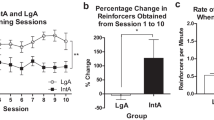Abstract
Rationale
The transition from stable to escalated drug intake has been demonstrated in rats self-administrating cocaine and heroin using a single dose of drug.
Objectives
To investigate the prolonged exposure to methamphetamine self-administration and the effect of various training doses of methamphetamine on the changes of methamphetamine intake over a 21-day period.
Methods
Two groups of rats were trained in 1-h daily sessions of methamphetamine self-administration [0.033 mg/infusion (inf); approximately 0.066 mg/kg/inf]. Methamphetamine access was increased to 6 h in one group [Long Access (LgA)] or maintained at 1 h in another [Short Access (ShA)]. The same procedure was repeated in rats exposed to different training doses of methamphetamine (0.05, 0.1, and 0.2 mg/kg/inf).
Results
In LgA rats, total and first hour intake of methamphetamine significantly increased compared to ShA rats at various methamphetamine doses. LgA animals, at all doses in the second study, escalated intake to 8–9 mg/kg per 6-h session, with the most rapid escalation occurring at 3–5 days at a methamphetamine dose of 0.1 mg/kg/inf.
Conclusions
The escalation of drug intake observed with extended access is produced at multiple doses of methamphetamine. The rapidity of escalation depends on the dose. Ultimately, all doses in the dose-response study engendered self-administration of the same amount of total drug in a 6-h session in the extended-access group. Results suggest that the rapidity of escalation is dependent on dose and has an upper limit of intake over a period of 21 days.





Similar content being viewed by others
References
Ahmed SH, Koob GF (1998) Transition from moderate to excessive drug intake: change in hedonic set point. Science 282:298–300
Ahmed SH, Koob GF (1999) Long-lasting increase in the set point for cocaine self-administration after escalation in rats. Psychopharmacology 146:303–312
Ahmed SH, Koob GF (2005) The transition to drug addiction: a negative reinforcement model based on an allostatic decrease in reward function. Psychopharmacology 180:473–490
Ahmed SH, Walker JR, Koob GF (2000) Persistent increase in the motivation to take heroin in rats with a history of drug escalation. Neuropsychopharmacology 22:413–421
Ahmed SH, Kenny PJ, Koob GF, Markou A (2002) Neurobiological evidence for hedonic allostasis associated with escalating cocaine use. Nat Neurosci 5:625–626
Ahmed SH, Lin D, Koob GF, Parsons LH (2003) Escalation of cocaine self-administration does not depend on altered cocaine-induced nucleus accumbens dopamine levels. J Neurochem 86:102–113
American Psychiatric Association (2000) Diagnostic and statistical manual of mental disorders: DSM-IV-TR. American Psychiatric Association, Washington, DC
Ben-Shahar O, Ahmed SH, Koob GF, Ettenberg A (2004) The transition from controlled to compulsive drug use is associated with a loss of sensitization. Brain Res 995:46–54
Bozarth MA, Wise RA (1985) Toxicity associated with long-term intravenous heroin and cocaine self-administration in the rat. J Am Med Assoc 254:81–83
Cadet JL, Brannock C (1998) Free radicals and pathology of brain dopamine systems. Neurochem Int 32:117–131
Caine SB, Lintz R, Koob GF (1993) Intravenous drug self-administration techniques in animals. In: Sahgal A (ed) Behavioral neuroscience: a practical approach, vol 2. Oxford University Press, New York, pp 117–143
Cox C, Smart RG (1970) The nature and extent of speed use in North America. Can Med Assoc J 102:724–729
Davidson C, Gow AJ, Lee TH, Elliswood EH (2001) Methamphetamine neurotoxicity: necrotic and apoptotic mechanisms and relevance to human abuse and treatment. Brain Res Rev 36:1–22
Deneau G, Yanagita T, Seevers MH (1969) Self-administration of psychoactive substances by the monkey. Psychopharmacologia 16:30–48
Derlet RW, Heischober B (1990) Methamphetamine. Stimulant of the 1990s? West J Med 153:625–628
Fukui S, Wada K, Iyo M (1994) Epidemiology of amphetamine abuse in Japan and its social implication. In: Cho AK, Segal DS (ed) Amphetamine and its analogs: psychopharmacology, toxicology, and abuse. Academic, San Diego, pp 459–478
Gawin FH, Ellinwood EH Jr (1989) Cocaine dependence. Annu Rev Med 40:149–161
Gonzalez Castro F, Barrington EH, Walton MA, Rawson RA (2000) Cocaine and methamphetamine: differential addiction rates. Psychol Addict Behav 14:390–396
Helschober B, Miller MA (1991) Methamphetamine abuse in California. In: Miller MA, Kozel NJ (eds) Methamphetamine abuse: epidemiologic issues and implications (series title: NIDA research monograph, vol 115). National Institute on Drug Abuse, Rockville, pp 60–71
Johanson CE, Balster RL, Bonese K (1976) Self-administration of psychomotor stimulant drugs: the effects of unlimited access. Pharmacol Biochem Behav 4:45–51
Kramer JC, Fischman VS, Littlefield DC (1967) Amphetamine abuse: pattern and effects of high doses taken intravenously. J Am Med Assoc 201:305–309
Kuczenski R, Segal DS (1994) Neurochemistry of amphetamine. In: Cho AK, Segal DS (eds) Amphetamine and its analogs: psychopharmacology, toxicology, and abuse. Academic, San Diego, pp 81–113
Pulvirenti L, Balducci C, Piercy M, Koob GF (1998) Characterization of the effects of the partial dopamine agonists terguride on cocaine self-administration in the rat. J Pharmacol Exp Ther 286:1231–1238
Riddle E, Topham M, Haycock J, Hanson G, Fleckenstein A (2002) Differential trafficking of the vesicular monoamine transporter-2 by methamphetamine and cocaine. Eur J Pharmacol 449:71–74
Smith NT, Corbascio AN (1970) The use and misuse of pressor agents. Anesthesiology 33:58–101
Acknowledgements
This is publication number 15369-NP from The Scripps Research Institute. The authors would like to thank Mike Arends and Mellany Santos for their assistance with manuscript preparation.
Author information
Authors and Affiliations
Corresponding author
Additional information
Research was supported by National Institutes of Health grant DA10072 from the National Institute on Drug Abuse.
Rights and permissions
About this article
Cite this article
Kitamura, O., Wee, S., Specio, S.E. et al. Escalation of methamphetamine self-administration in rats: a dose–effect function. Psychopharmacology 186, 48–53 (2006). https://doi.org/10.1007/s00213-006-0353-z
Received:
Accepted:
Published:
Issue Date:
DOI: https://doi.org/10.1007/s00213-006-0353-z




